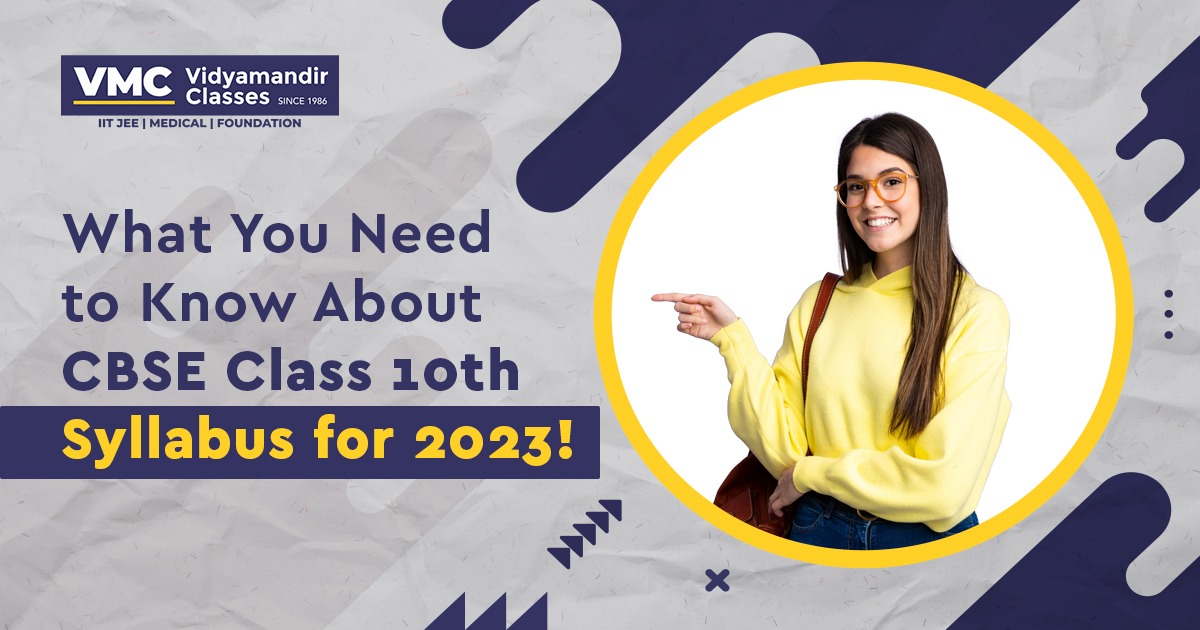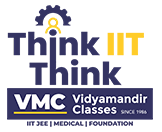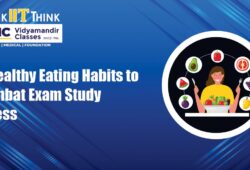What You Need to Know About CBSE Class 10th Syllabus for 2023!
 Posted On
Posted On
487 total views, 2 views today
The updated course material for Class 10 has been released by the Central Board of Secondary Education. This year, there have been more cuts to the new syllabus for important disciplines. The term-based test system will be eliminated by the board authorities, and the single board exam system will be reinstated. Students can check the whole Class 10 syllabus on the official website.
The updated syllabus for Class 10th is provided below for students to review:
Science Curriculum
Theme: Materials
Unit I: Chemical Substances – Nature and Behaviour
- Chemical reactions: Chemical equation, Balanced chemical equation, implications of a balanced chemical equation, types of chemical reactions: combination, decomposition, displacement, double displacement, precipitation, endothermic exothermic reactions, oxidation and reduction.
- Acids, bases and salts: Their definitions in terms of furnishing of H+ and OH– ions, General properties, examples and uses, neutralization, concept of pH scale (Definition relating to logarithm not required), importance of pH in everyday life; preparation and uses of Sodium Hydroxide, Bleaching powder, Baking soda, Washing soda and Plaster of Paris.
- Metals and nonmetals: Properties of metals and non-metals; Reactivity series; Formation and properties of ionic compounds; Basic metallurgical processes; Corrosion and its prevention.
- Carbon compounds: Covalent bonding in carbon compounds. Versatile nature of carbon. Homologous series. Nomenclature of carbon compounds containing functional groups (halogens, alcohol, ketones, aldehydes, alkanes and alkynes), difference between saturated hydro carbons and unsaturated hydrocarbons. Chemical properties of carbon compounds (combustion, oxidation, addition and substitution reaction). Ethanol and Ethanoic acid (only properties and uses), soaps and detergents.
Theme: The World of the Living
Unit II: World of Living
- Life processes: ‘Living Being’. Basic concept of nutrition, respiration, transport and excretion in plants and animals.
- Control and co-ordination in animals and plants: Tropic movements in plants; Introduction of plant hormones; Control and co-ordination in animals: Nervous system; Voluntary, involuntary and reflex action; Chemical co-ordination: animal hormones.
- Reproduction: Reproduction in animals and plants (asexual and sexual) reproductive health – need and methods of family planning. Safe sex vs HIV/AIDS. Child bearing and women’s health.
- Heredity and Evolution: Heredity; Mendel’s contribution- Laws for inheritance of traits: Sex determination: brief introduction: (topics excluded – evolution; evolution and classification and evolution should not be equated with progress).
Theme: Natural Phenomena
Unit III: Natural Phenomena
- Reflection of light by curved surfaces; Images formed by spherical mirrors, centre of curvature, principal axis, principal focus, focal length, mirror formula (Derivation not required),magnification. Refraction; Laws of refraction, refractive index.
- Refraction of light by spherical lens; Image formed by spherical lenses; Lens formula (Derivation not required); Magnification. Power of a lens.
- Functioning of a lens in human eye, defects of vision and their corrections, applications of spherical mirrors and lenses.
- Refraction of light through a prism, dispersion of light, scattering of light, applications in daily life (excluding colour of the sun at sunrise and sunset).
Theme: How Things Work
Unit IV: Effects of Current
- Electric current, potential difference and electric current. Ohm’s law; Resistance, Resistivity, Factors on which the resistance of a conductor depends. Series combination of resistors, parallel combination of resistors and its applications in daily life. Heating effect of electric current and its applications in daily life. Electric power, Interrelation between P, V, I and R.
- Magnetic effects of current: Magnetic field, field lines, field due to a current carrying conductor, field due to current carrying coil or solenoid; Force on current carrying conductor, Fleming’s Left Hand Rule, Direct current. Alternating current: frequency of AC. Advantage of AC over DC. Domestic electric circuits.
Theme: Natural Resources
Unit V: Natural Resources
- Our environment: Eco-system, Environmental problems, Ozone depletion, waste production and their solutions. Biodegradable and non-biodegradable substances
Math’s Curriculum
UNIT I: NUMBER SYSTEMS
- REAL NUMBER
Fundamental Theorem of Arithmetic – statements after reviewing work done earlier and after illustrating and motivating through examples.
UNIT II: ALGEBRA
- POLYNOMIALS
Zeros of a polynomial. Relationship between zeros and coefficients of quadratic polynomials.
- PAIR OF LINEAR EQUATIONS IN TWO VARIABLES
Pair of linear equations in two variables and graphical method of their solution, consistency/inconsistency.
Algebraic conditions for number of solutions. Solution of a pair of linear equations in two variables algebraically – by substitution, by elimination. Simple situational problems.
- QUADRATIC EQUATIONS
Standard form of a quadratic equation ax2 + bx + c = 0, (a ≠ 0). Solutions of quadratic equations (only real roots) by factorization, and by using quadratic formula. Relationship between discriminant and nature of roots.
Situational problems based on quadratic equations related to day to day activities to be incorporated.
- ARITHMETIC PROGRESSIONS
Motivation for studying Arithmetic Progression Derivation of the nth term and sum of the first n terms of A.P. and their application in solving daily life problems.
UNIT III: COORDINATE GEOMETRY
- Coordinate Geometry
Review: Concepts of coordinate geometry, graphs of linear equations. Distance formula. Section formula (internal division).
UNIT IV: GEOMETRY
- TRIANGLES
Definitions, examples, counter examples of similar triangles.
1. (Prove) If a line is drawn parallel to one side of a triangle to intersect the other two
sides in distinct points, the other two sides are divided in the same ratio.
2. (Motivate) If a line divides two sides of a triangle in the same ratio, the line is parallel
to the third side.
3. (Motivate) If in two triangles, the corresponding angles are equal, their corresponding
sides are proportional and the triangles are similar.
4. (Motivate) If the corresponding sides of two triangles are proportional, their
corresponding angles are equal and the two triangles are similar.
5. (Motivate) If one angle of a triangle is equal to one angle of another triangle and the
sides including these angles are proportional, the two triangles are similar.
- CIRCLES
Tangent to a circle at, point of contact
1. (Prove) The tangent at any point of a circle is perpendicular to the radius through the
point of contact.
2. (Prove) The lengths of tangents drawn from an external point to a circle are equal.
UNIT V: TRIGONOMETRY
1. INTRODUCTION TO TRIGONOMETRY
Trigonometric ratios of an acute angle of a right-angled triangle. Proof of their
existence (well defined); motivate the ratios whichever are defined at 0o and 90o. Values
of the trigonometric ratios of 300, 450 and 600. Relationships between the ratios.
2. TRIGONOMETRIC IDENTITIES
Proof and applications of the identity sin2A + cos2A = 1. Only simple identities to be given.
3. HEIGHTS AND DISTANCES: Angle of elevation, Angle of Depression.
Simple problems on heights and distances. Problems should not involve more than two
right triangles. Angles of elevation / depression should be only 30°, 45°, and 60°.
UNIT VI: MENSURATION
1. AREAS RELATED TO CIRCLES
Area of sectors and segments of a circle. Problems based on areas and perimeter /circumference of the above said plane figures. (In calculating area of segment of a circle, problems should be restricted to central angle of 60°, 90° and 120° only.
2. SURFACE AREAS AND VOLUMES
Surface areas and volumes of combinations of any two of the following: cubes, cuboids, spheres, hemispheres and right circular cylinders/cones.
UNIT VII: STATISTICS AND PROBABILITY
1. STATISTICS
Mean, median and mode of grouped data (bimodal situation to be avoided).
2. PROBABILITY
Classical definition of probability. Simple problems on finding the probability of an event.
Social Science Curriculum
Unit 1: India and the Contemporary World – II
Themes
Section 1: Events and Processes:
The Rise of Nationalism in Europe:
- The French Revolution and the Idea of the Nation
- The Making of Nationalism in Europe
- The Age of Revolutions: 1830-1848
- The Making of Germany and Italy
- Visualizing the Nation
- Nationalism and Imperialism
Nationalism in India:
- The First World War, Khilafat and Non – Cooperation
- Differing Strands within the Movement
- Towards Civil Disobedience
- The Sense of Collective Belonging
Section 2: Livelihoods, Economies and Societies:
The Making of a Global World:
- The Pre-modern world
- The Nineteenth Century (1815-1914)
- The Inter war Economy
- Rebuilding a World Economy: The Post-War Era
The Age of Industrialization:
- Before the Industrial Revolution
- Hand Labour and Steam Power
- Industrialization in the Colonies
- Factories Come Up
- The Peculiarities of Industrial Growth
- Market for Goods
Section 3: Everyday Life, Culture and Politics:
Print Culture and the Modern World:
- The First Printed Books
- Print Comes to Europe
- The Print Revolution and its Impact
- The Reading Mania
- The Nineteenth Century
- India and the World of Print
- Religious Reform and Public Debates
- New Forms of Publication
- Print and Censorship
Unit 2: Contemporary India – II
Themes
Resources and Development:
- Concept
- Development of Resources
- Resource Planning – Resource Planning in India, Conservation of Resources
- Land Resources
- Land Utilization
- Land Use Pattern in India
- Land Degradation and Conservation Measures
- Soil as a Resource – Classification of Soils, Soil Erosion and Soil Conservation (excluding Box Information on State of India’s Environment)
Forest and Wildlife:
- Conservation of forest and wildlife in India
- Types and distribution of forests and wildlife resources
- Community and Conservation
Water Resources:
- Water Scarcity and The Need for Water Conservation and Management
- Multi-Purpose River Projects and Integrated Water Resources Management
- Rainwater Harvesting
Agriculture:
- Types of Farming – Primitive Subsistence, Intensive Subsistence, Commercial
- Cropping Pattern – Major Crops, Food
- Crops other than Grains, Non Food Crops, Technological and Institutional Reforms
- Food Security (excluding impact of globalization on agriculture)
Minerals and Energy Resources
- What is a mineral?
- Mode of occurrence of Minerals – Where are these minerals found?, Ferrous Minerals, Non-Ferrous Minerals, NonMetallic Minerals, Rock Minerals
- Conservation of Minerals
- Energy Resources – Conventional Sources of Energy, Non-Conventional Sources of Energy
- Conservation of Energy Resources
Manufacturing Industries:
- Importance of Manufacturing – Industrial Location (excluding Industry Market Linkage), Agro based Industry (excluding Cotton Textiles, Jute Textiles, Sugar Industry), Mineral based Industries (excluding Iron Steel Industry, Cement Industry), Industrial Pollution and Environmental Degradation, Control of Environmental Degradation
Life Lines of National Economy:
- Roadways
- Railways
- Pipelines
- Waterways
- Major Seaports
- Airways
- Communication
- International Trade
- Tourism as a Trade
Unit 3: Democratic Politics
Themes
Power Sharing:
- Belgium and Sri Lanka
- Majoritarianism in Sri Lanka
- Accommodation in Belgium
- Why power sharing is desirable?
- Forms of Power Sharing
Federalism:
- What is Federalism?
- What make India a Federal Country?
- How is Federalism practiced?
- Decentralization in India
Gender, Religion and Caste:
- Gender and Politics – Public/Private division, Women’s political representation
- Religion, Communalism and Politics – Communalism, Secular State (excluding image on page 46, 48, 49 of NCERT Textbook – Democratic Politics –II- reprinted edition 2021)
- Caste and Politics – Caste inequalities, Caste in politics, Politics in caste
Political Parties:
- Why do we need Political Parties? – Meaning, Functions, Necessity
- How many parties should we have?
- National Parties
- State Parties
- Challenges to Political Parties
- How can Parties be reformed?
Outcomes of Democracy:
- How do we assess democracy’s outcomes?
- Accountable, responsive and legitimate government
- Economic growth and development
- Reduction of inequality and poverty
- Accommodation of social diversity
- Dignity and freedom of the citizens
Unit 4: Understanding Economic Development
Themes
Development:
- What Development Promises – Different People, Different Goals
- Income and Other Goals
- National Development
- How to compare different countries or states?
- Income and other criteria
- Public Facilities
- Sustainability of Development
Sectors of the Indian Economy:
- Sectors of Economic Activities
- Comparing the three sectors
- Primary, Secondary and Tertiary Sectors in India
- Division of sectors as organized and unorganized
- Sectors in terms of ownership: Public and Private Sectors
Money and Credit:
- Money as a medium of exchange
- Modern forms of Money
- Loan activities of Banks
- Two different Credit situations
- Terms of Credit
- Formal Sector Credit in India
- Self Help Groups for the Poor
Globalization and the Indian Economy:
- Production across countries
- Interlinking production across countries
- Foreign Trade and integration of markets
- What is Globalization?
- Factors that have enabled Globalization
- World Trade Organization
- Impact of Globalization in India
- The Struggle for a fair Globalization
Consumer Rights:
- To be used only for Project Work
Source: https://cbseacademic.nic.in/curriculum_2023.html
Final Thoughts
Students in Class 10 who will be taking the board examinations in 2023 can now download their practice tests/mock board papers from https://www.vidyamandir.com/. Additionally, Vidyamandir Classes is the best place for students to get better coaching and assistance while they get ready for their JEE exams. So, Think IIT, Think VMC.


